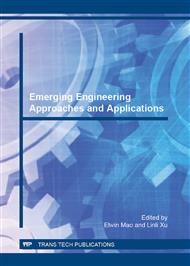[1]
X. D. Song, Y. Chi, K. Hino, B.L. Tseng, Information flow modeling based on diffusion rate for prediction and ranking, World Wide Web Conf., pp.191-200, (2008).
DOI: 10.1145/1242572.1242599
Google Scholar
[2]
X. F. Luo, Z. Xu, J. Yu, F. F. Liu, Discovery of associated topics for the intelligent browsing, IEEE Conf. on Ubi-Media Computing, pp.119-125, (2008).
DOI: 10.1109/umedia.2008.4570876
Google Scholar
[3]
X. Chen, X.F. Luo, S.X. Zhang and Z. Xu, Analysis and Modeling of the Semantically Associated Network on the Web, Concurrency and Computation: Practice and Experience, vol. 22, no. 7, pp.767-787, (2010).
Google Scholar
[4]
H. Zhuge, X Chen, X. P. Sun, E.L. Yao, HRing: a structured P2P overlay based on Harmonic Series, IEEE TPDS, vol. 19, no. 2, pp.145-158, (2008).
DOI: 10.1109/tpds.2007.70725
Google Scholar
[5]
Y.W. Zhu, H.H. Wang, Y.M. Hu, Integrating semantics-based access mechanism with P2P file systems, IEEE P2P Computing, pp.118-125, (2003).
DOI: 10.1109/ptp.2003.1231511
Google Scholar
[6]
H. V. Jagadish, B. C. Ooi and Q. H. Vu, BATON: A Balanced Tree Structure for Peer-to-Peer Networks, Proc. Proc. 31th Int'l Conf. on Very Large Data Bases (VLDB), pp.661-672, (2005).
Google Scholar
[7]
W. Pugh, Skip Lists: A Probabilistic Alternative to Balanced Trees, Communications of the ACM, vol. 33, no. 6, pp.668-676, (1990).
DOI: 10.1145/78973.78977
Google Scholar
[8]
N. J. A. Harvey, M. B. Jones, S. Saroiu, M. Theimer and A. Wolman, SkipNet: a Scalable Overlay Network with Practical Locality Properties, Proc. 4th USENIX Symposium on Internet Technologies and Systems (USITS), pp.113-126, (2003).
Google Scholar
[9]
J. Aspnes and G. Shah, Skip Graphs, Proc. 14th Annual ACM-SIAM Symposium on Discrete Algorithms (SODA), pp.384-393, (2003).
Google Scholar
[10]
J. Kleinberg, the Small-World Phenomenon: an Algorithmic Perspective, Proc. 32nd ACM Symposium on Theory of Computing (STOC), pp.163-170, (2000).
Google Scholar


